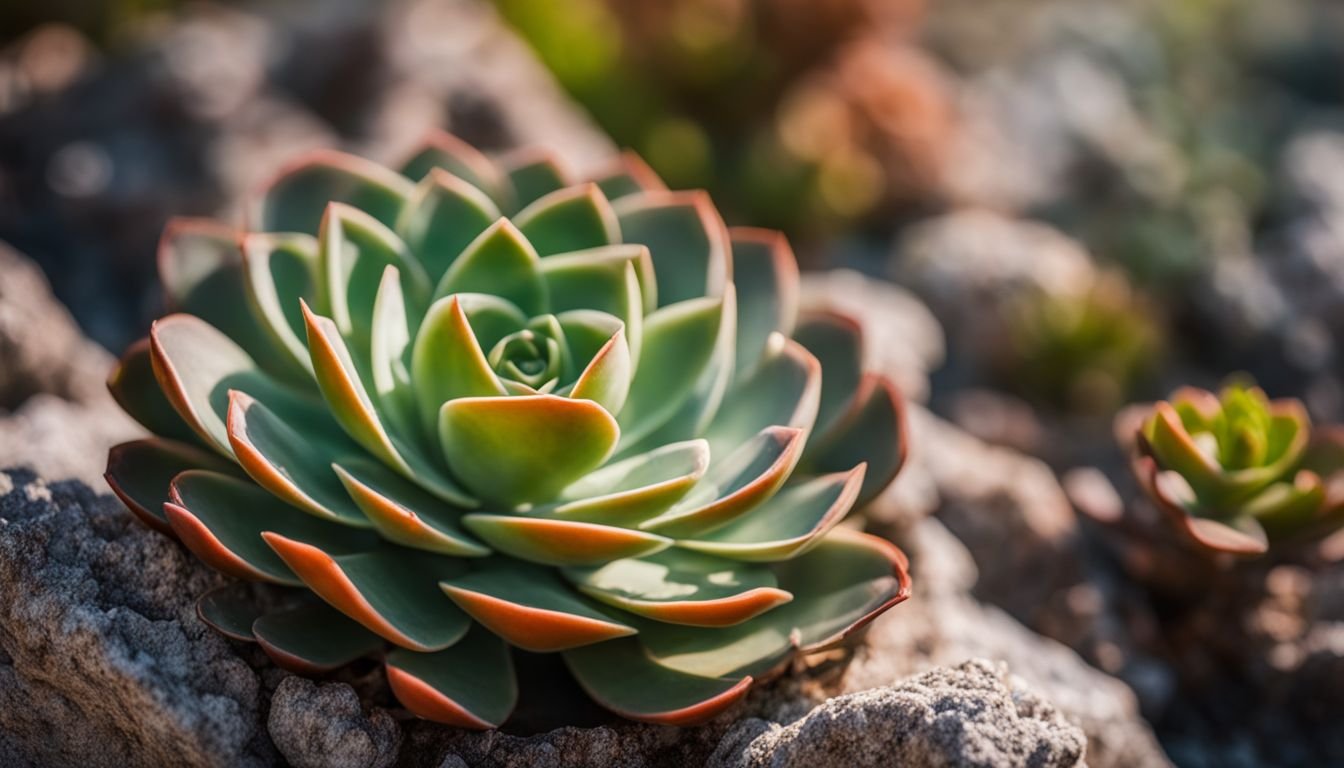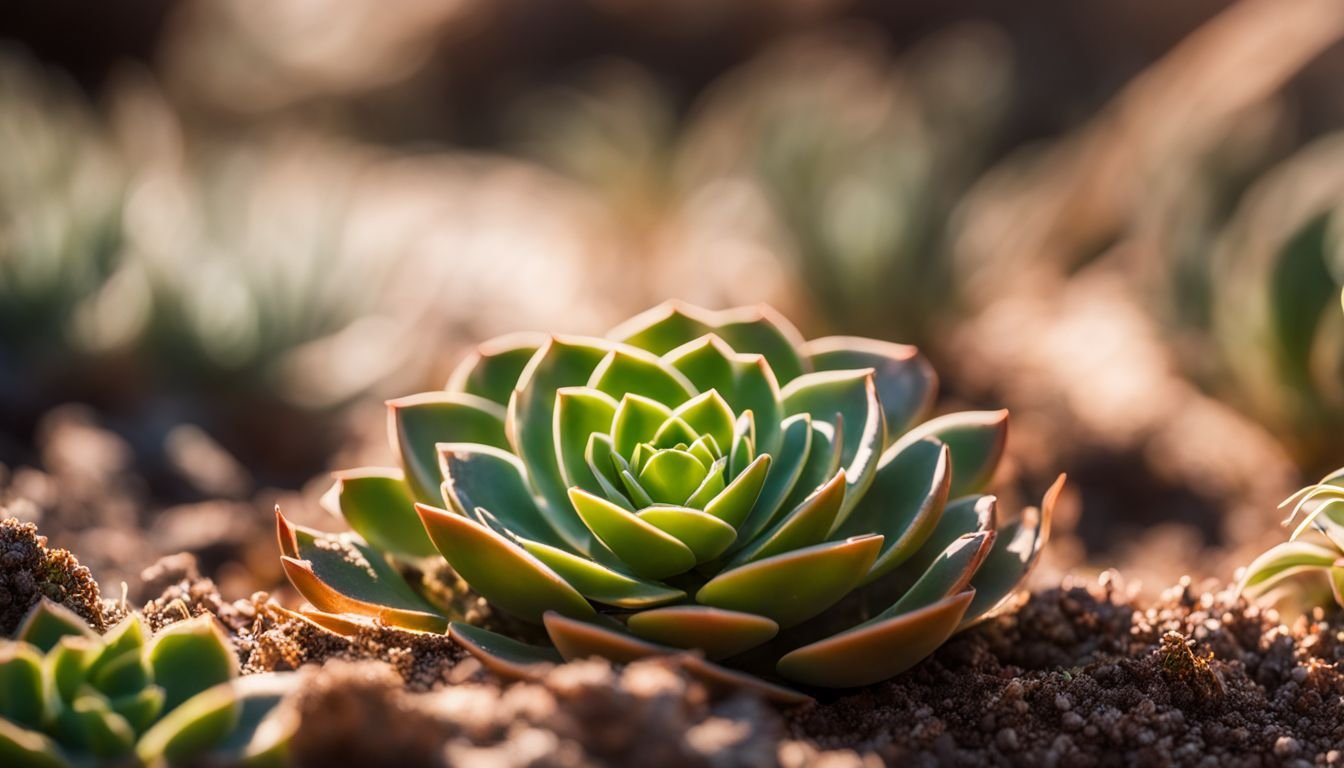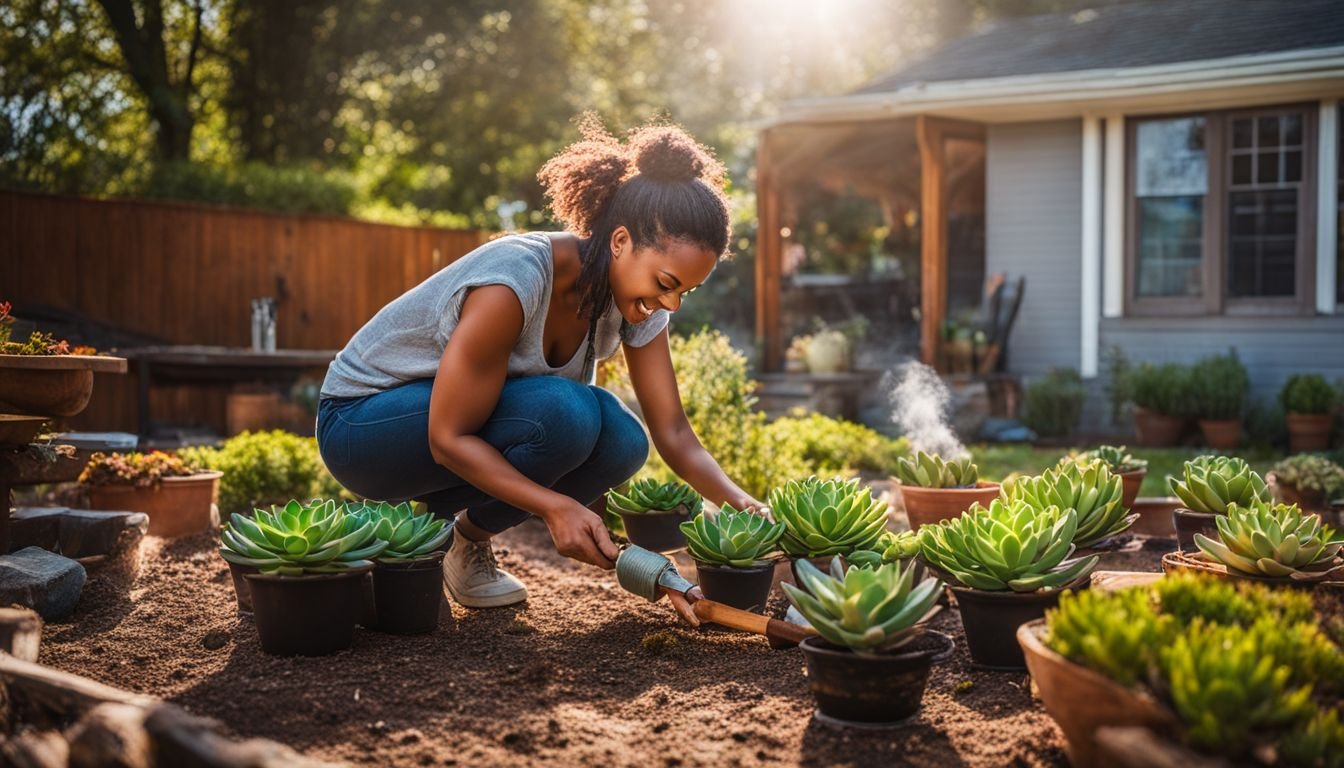Gardening in this sunburnt country of ours sure comes with a fair share of challenges, especially when you’re on the hunt for the right plants that’ll not only survive but thrive under our unique conditions.
Believe me, we’ve all felt that sting of disappointment when plants don’t seem to take too kindly to where they‘ve been planted.
That’s exactly why we’ve turned our focus towards the Crassula Campfire succulent – a real stunner known for its brilliant orange-red leaves that shine bright under full sun.
After diving deep into research and giving it a crack ourselves, we reckon this easy-care beauty is just the ticket for both green thumbs and gardening rookies alike. We’ve put together this guide brimming with tips on how to grow and look after these eye-catching succulents, aiming for success whether indoors or out in the sticks.
Whether you’re keen as mustard to spruce up your rockery or in need of a tough-as-nails ground cover that pretty much looks after itself once settled in – we’re here to help.
Alrighty then, let’s get stuck into growing some colour!
Key Takeaways
- Crassula Campfire succulents love soaking up the sun and need well – draining soil to avoid water pooling around their roots, which is essential for their growth both indoors and outdoors.
- You can easily propagate Crassula Campfire by using parts of leaves or stems in spring and summer, making sure they are planted in soil that drains well and kept under bright but indirect sunlight until they establish themselves.
- Watering should be done carefully; only when the top layer of soil feels dry as these plants are drought-tolerant. Overwatering can cause harm, so it’s better to check the soil before watering again.
- Fertilising with a quality cactus blend once during the growing season helps keep your Crassula Campfire healthy without overwhelming it with too many nutrients.
- Keep Crassula Campfire out of reach from pets and children since its leaves might cause irritation on some people’s skin. Always wear gloves when handling this plant to avoid any discomfort.
Understanding the Crassula Campfire Succulent

We’re diving into the world of Crassula Campfire, a vibrant member of the Crassulaceae family. This plant thrives in warmer climates and adds a pop of color to rock gardens and containers.
Description and Features
The Crassula Campfire succulent stands out with its spirals of plump leaves that dazzle in bright orange-red under the sun. This plant thrives both indoors and outdoors, making it a flexible choice for gardeners.
With its ability to spread up to 1 metre wide, it’s perfect for covering ground in dry gardens known as xeriscaping. It’s not just about looks; this succulent is tough, handling drought well once it gets settled.
This colourful plant comes from the Crassulaceae family and fits beautifully into various settings, whether you’re aiming to add vibrance to your rockeries or seeking a striking indoor companion.
When given free-draining soil and enough light, its leaves turn a fiery shade, creating an eye-catching display. Tubestock plants are available with a robust young root system ensuring they’ll grow strong and healthy.
“Crassula Campfire paints your garden with fire without ever lighting a match.”
Ideal Climate and Environment
Crassula Campfire succulents love the sun and dry conditions. They need soil that drains well. These plants show their best colors and shapes when they soak up loads of sunlight. In gardens, we plant them where the sun shines bright all day.
This could be in rocky parts, pots, or even as ground coverings.
For us Aussies who enjoy gardening, creating a mini-environment that mimics their natural habitat is key. Think about adding rocks and sand to improve drainage in the soil. This way, water runs through quickly without pooling around the roots.
Keeping them in sunny spots ensures they grow strong and colorful.
Maintaining this type of environment supports their growth outdoors but works indoors too with the right setup. Use pots with holes at the bottom for better water flow and place them near windows where they get plenty of light during the day.
How to Grow Crassula Campfire Succulents

Growing Crassula Campfire succulents starts with the right method of propagation. You can use parts of leaves or stems to start new plants. Make sure you plant them in soil that drains well for best results.
They need a good amount of sunlight too, but not too much direct light all at once. Keep these tips in mind, and you’ll see your Crassula Campfire thrive.
Propagation Techniques
We love sharing our gardening tips with fellow Australians who have a passion for plants. Today, we’re focusing on how to multiply your Crassula Campfire succulents.
- Choose the right time of year: Propagation works best in spring and summer when the plant is actively growing.
- Prepare for stem cuttings: First, snip a healthy branch from your main plant. Make sure your scissors are clean to avoid disease spread.
- Let cuttings dry: Place the stem aside in a sheltered spot for a few days until the cut end forms a callous.
- Soil selection matters: Use soil that drains well. This prevents water from pooling around the roots.
- Potting the cuttings: Plant calloused stems in your chosen soil, just deep enough to stand upright.
- Leaf technique varies slightly: Instead of a stem, gently twist a leaf from the mother plant. Let it dry and follow similar steps as with stem propagation.
- Water requirements: After planting, keep the soil lightly moist but not soaked to encourage rooting without rotting.
- Location is key: Set your newly potted succulents somewhere they can get bright but indirect sunlight until they establish themselves.
Following these steps will help you grow more Crassula Campfire plants successfully. Keep an eye on their progress and enjoy seeing them thrive under your care!
Ideal Soil Conditions
Moving from propagation techniques, it’s crucial to focus on creating the perfect home for your Crassula Campfire. Free-draining soil tops the list of must-haves. This plant thrives in an environment where water doesn’t linger around its roots, making well-draining potting mix or sandy loam ideal choices.
Mix in gravel or perlite to improve drainage if you’re working with heavier soils.
“Give them the right foundation, and they’ll stand strong.”
A common mistake is over-loving our succulents with too much water. For these drought-tolerant fighters, drenching them only when their soil has gone completely dry works best. It typically takes about 12 weeks for Crassula Campfire to settle into new surroundings; during this time, keep a close eye on moisture levels without going overboard.
After this period, let nature’s semi-arid conditions inspire your care routine – minimal watering mirrors their natural habitat perfectly.
Ensuring your Crassula Campfire has the right blend of soil not only anchors them physically but ensures they flourish under Australian skies, ready to face both blazing summers and chilly winds without faltering.
Sunlight and Temperature Requirements
Crassula Campfire succulents love soaking up the sun. They need full sunlight to show off their vibrant colors and maintain a compact shape. We make sure ours get plenty of rays throughout the day, especially in Australia’s generous sunshine.
The bright light helps them turn from green to a stunning red, creating a fiery look that lives up to their name.
We keep our plants in spots where they can enjoy sunlight for at least a few hours daily. Even though they adore the warmth, it’s smart to watch out for extremely hot temperatures which might harm them.
These succulents thrive in temperate conditions, so we aim for that perfect balance between sunbaked days and cooler evenings.
Ensuring these conditions can sometimes challenge those living in areas with less predictable weather patterns or micro-climates different from the Australian climate norm. Yet, with some creativity in placement – perhaps near trees or mountains that provide occasional shade – we find ways to give our Crassula Campfire everything they need without risking damage from overexposure.
Caring for Crassula Campfire Succulents
We all need to give our Crassula Campfire Succulents the right amount of water. They thrive with less water, so overdoing it can harm them. Keep an eye on their leaves; they’ll tell you if they’re happy or need more care.
When it comes to feeding these beauties, a little bit of plant food during growing season does wonders. This keeps them bright, colorful, and healthy.
Watering Guidelines
Caring for Crassula Campfire Succulents means getting the watering just right. These plants love conditions that mimic their native environment.
- Start by watering your succulent deeply when you first plant it. This helps it to establish a strong root system.
- Once your Crassula Campfire is settled in, check the soil before adding more water. The top layer should feel completely dry to the touch.
- Because these plants are drought – resistant, they don’t need water too often. Wait until the soil is dry and then give them a good drink.
- Avoid letting water sit on the leaves for long periods. This can lead to rot, which might damage or kill your plant.
- In hotter months, you may need to water your succulent more frequently due to increased evaporation rates.
- During winter, reduce watering significantly as the plant goes into a dormant state and uses much less water.
- If you’re growing Crassula Campfire indoors, make sure its pot drains well and never let it sit in a tray of water.
Following these guidelines will help ensure your Crassula Campfire thrives, showcasing those stunning red and green leaves that we all adore so much.
Fertilisation Needs
After making sure your Crassula Campfire succulents get enough water, it’s time to talk about feeding them. These plants need food just like we do. We recommend using a top-notch cactus blend to fertilise your Crassula Campfire.
This specific blend gives them all the nutrients they need without going overboard.
Be careful not to overfeed these succulents. Giving them too much fertiliser can harm more than help. Stick to fertilising only once during their growing season in spring or summer.
This will keep your Crassula Campfire happy and healthy without overwhelming it with too many nutrients.
Potential Health Issues and Solutions
Caring for Crassula Campfire succulents brings joy and a dash of colour to our gardens. But we must also focus on keeping them safe from harm and ensuring they don’t cause any issues for us or our pets.
- The Crassula Campfire’s leaves can be tough on the skin. They might cause itching or a rash in some folks. To avoid this, always wear gloves when handling the plant.
- Experience any discomfort after touching the plant? Wash the area with soap and water straight away. If the irritation persists, it’s wise to seek medical advice.
- We all cherish our furry friends and little ones, making it crucial to place these succulents out of their reach. This prevents them from nibbling on the plant, which could lead to health troubles.
- Since these plants become part of our home, knowing how to react if someone ingests a piece is key. Acting swiftly by rinsing the mouth and consulting a physician can prevent serious issues.
Up next, let’s discuss how cultivating these succulents indoors compares with growing them outdoors.
Indoor vs Outdoor Cultivation of Crassula Campfire
Choosing where to grow your Crassula Campfire succulents, whether inside or out, is a key decision. We love these plants for their versatility and vibrant color, which can enhance both home and garden. Here’s a simple guide to help you decide the best spot for your Crassula Campfire, ensuring it thrives.
| Location | Advantages | Disadvantages | Special Considerations |
|---|---|---|---|
| Indoors | Protection from extreme weather. Control over sunlight exposure. | May require additional lighting. Risk of overwatering. | Use pots with drainage holes. Place near a bright window. |
| Outdoors | Natural sunlight. Ideal for rockeries and groundcover. | Exposed to weather changes. Pests. | Choose a spot with morning sunlight. Ensure soil is free-draining. |
Both inside and outside growth offer unique benefits for Crassula Campfire succulents. Inside, you control their environment. Outside, they get natural sunlight. Each option requires specific care, like proper soil and avoiding too much water. Whether you pick an indoor shelf or an outdoor garden, your Crassula Campfire will grow beautifully with the right attention.
Conclusion
Growing and caring for Crassula Campfire succulents brings a splash of color to your garden or home. These plants, with their vibrant orange-red leaves, are perfect for adding life to any space.
We’ve shown you how easy it is to get them thriving, whether indoors or out in the Australian sun. By following our simple guide on soil, sunlight, watering, and more, you’ll enjoy these stunning plants all year round.
Let’s fill our spaces with the beauty of Crassula Campfire succulents and watch as they transform our gardens into works of art.
FAQs
1. How do I start growing Crassula Capitella ‘Campfire’?
You can begin by using leaf cuttings to grow your Crassula Capitella ‘Campfire’. Make sure you plant them in soil that drains well and place them where they’ll get plenty of sunlight.
2. What climatic conditions are best for Crassula Campfire succulents?
These succulents thrive in climates with low humidity. They prefer warm, tropical conditions but can adapt to a bit of deviation as long as they’re not overwatered.
3. How often should I water my Crassula Campfire plants?
Water your Crassula Campfire when the soil feels dry to the touch. It’s important not to over-water as this can harm the plant more than under-watering.
4. Can I keep my Crassula Campfire outside all year round?
In Australia, you might be able to keep it outside if the weather is warm and there’s no risk of frost. However, during colder months or unexpected cold snaps, it’s safer to bring them indoors.
5. What should I do if my succulent gets a disease or pest problem?
Firstly, isolate the infected plant from your other plants to prevent spreading. Then treat it with appropriate remedies available at garden centres or seek advice from professionals who specialise in succulent care.
6. Is transplanting necessary for Crassula Campfire succulents?
Yes, transplanting helps manage their growth and health. Do this carefully without damaging their roots and ensure they’re placed back into suitable soil with good drainage.
